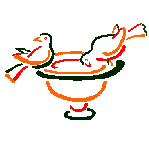 For some time now I've wanted to write The Big Book of Un-Preached Sermons, a disquisition on the Shadow Gospel: that body of Christic teaching that remains largely unknown to lay Christians, owing to surgical inaction by church leaders.
For some time now I've wanted to write The Big Book of Un-Preached Sermons, a disquisition on the Shadow Gospel: that body of Christic teaching that remains largely unknown to lay Christians, owing to surgical inaction by church leaders.It's a remarkably large canon.
My all-time favourite constituent, and one that continues to be a cornerstone of my Zen practice, is Matthew 6:6:
But thou, when thou prayest, enter into thy closet, and when thou hast shut thy door, pray to thy Father which is in secret; and thy Father which seeth in secret shall reward thee openly.I've never heard any clerical commentary on this directive. Reasons aren't hard to divine; Christian militants often use public prayer as a form of demonstration, even confrontation. Some will performance-pray at the drop of a hat, and given the chance, force it into public spaces and government proceedings. These people don't even seem to own a closet, let alone know how to use it.
Sadly, their detractors seldom include other Christians. At least not ones objecting on doctrinal grounds. Still, the Christ of Matthew is categorical: prayer is not prayer when others can see it.
It's not a minor point. What's at issue is nothing less that the total undoing – or at least the not-doing – of the central practice Jesus gave his disciples.
Speaking of central practices, you know what else is not itself in public?
Meditation.
I've held forth many times (here and here and here and here and here) on the strange fact that Buddhism – a solitary eremitical religion founded by the solitary eremitical Buddha – has become a pyramid scheme, to the point that actual Buddhic practitioners are now viewed as heretics. Strangest of all is the contention that the only "real" practice is collective. Authentic zazen, I'm assured, only happens when you sit with others – the more, the better. I've also been informed that the solitary sesshins I sit four times a year… aren't. Same rationale: it's only meditation if someone else is watching.
The greatest danger of this hokum is not that it reverses the Buddha's teaching and lifelong example. It's that it's crap.
I've meditated in public. I was a committed Zen centre member for several years, during which I sat formal zazen in the zendo with the assembled sangha at least twice a week. Even as a hermit, I sometimes sit in circumstances where passersby may, uh… pass by. And I'm here to tell you that the moment onlookers – or even the possibility of onlookers – enter the mix, meditation goes right out the window. Now you're playing "look-how-Zen-I-am": all posture and reputation and approval. That's not practicing. It's acting.
Jesus got this. The instant others see you praying, you stop talking to God and start talking to them. In fact, you start lying to them, about talking to God. You pile sin on top of apostasy on top of wasted effort.
It's true that diligent practice can overcome this: I once experienced kensho at the end of a zendo sesshin. I stopped caring about the opinions of peers and entered a state of unselfed clarity for a few hours. But it wasn't any deeper than the kensho I've experienced alone, and the presence of others was an impediment to it, not a catalyst.
I believe collective zazen, like collective prayer, can be a valid form. It rarely accomplishes the goals of Buddhic practice, but it may achieve others that, though less vital, are nonetheless worthwhile. (It can build community and shore up personal resolve.)
However, when public displays of communion are weaponised – when they're used to intimidate or indoctrinate – then the sangha must step up and restore right action.
(The Anchorite, by Franciszek Ejsmond, courtesy of the Muzeum Narodowe w Warszawie and Wikimedia Commons.)








